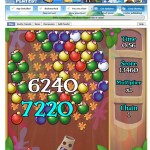
image by zugaldia
Over the years I’ve made quite a few casual games, and played absolutely tons of casual, indie, facebook and mainstream games. As I result I’ve seen plenty of tutorials ranging from non-existent to fantastic. Getting your tutorial right is a fine art and will greatly affect the sales of your game if you are using the Try before Buy model that most casual game portals use. Even if you aren’t using that model, you still want everyone who plays your game to really get into it and tell their friends how great it is – so a good tutorial is vital and not something that should be tacked on at the last minute (which of course it often is due to time/budget constraints – something that I’ve been guilty of myself).
Here are some tips to get you started. Of course every game is different and yours may need a different approach, but hopefully these general guidelines should help:
1: Make a List
List out all the unique game mechanics/features/content in your game.
2: Mark the Important Features
Mark the important items on your list that you want to introduce with a tutorial element of some kind. You may not want to introduce everything if you want players to discover some things naturally.
3: Order the List
Order the list appropriately, which means a) in difficulty AND b) in coolness (to make new players see the epic possibilities of the game).
If you are doing a demo, figure out what to show in the demo and what to leave for the full version (perhaps >50% of features in demo, but not >50% of levels i.e. the full version is padded with more levels using the features in clever ways).
4: Construct Tutorial Levels
Construct (or use existing levels) to show off the mechanics in your chosen order.
5: Have some non-tutorial levels
Make sure there are some levels that don’t introduce anything new but get players to practice previously learned stuff, perhaps in a combined manner. This way it won’t feel like there’s a constant barrage of tutorial levels. Also it helps to pad/pace the demo a little bit.
6: Avoid Modal Windows
Try to avoid modal tutorial dialogs (where you have to read the text + press OK to clear) wherever possible. Sometimes it’s really not possible to avoid a couple of these.
7: Use Popups
Use popups on screen with an animated arrow pointing to the item of interest. These will disappear when the user performs the action.
Alternatively/additionally consider tutorials in the game world that you can walk past and read, and structure the game levels so that you can’t proceed without solving the simple tutorial, and be sure to repeat the lesson in a slightly different way (without tutorial text) soon after so it’s not forgotten.
8: Use Dynamic Popups
Some popups will be at the start of the level or trigger when a normal event/sequence of actions occurs (works better in sandbox-type games). Others will be for special edge cases where the player may have done something wrong (or way cool) and you want to inform them of that.
Don’t forget to point to things like goals or picked up items on the HUD that you want to draw the player’s attention to.
9: Edit the Text
Wield the knife on tutorial text. Make it as small as possible whilst retaining the core message (leave out extra details for skilled players to find out themselves). I’ve seen some very long and wordy tutorial text before than could have been reduced to just a few words.
If English is not your first language and the game is being sold on English sites, then get someone English (who is good with writing) to edit it for you.
10: Use Image/Animations
Try to add images/animations to important tutorial popups that show the player what they are trying to do (picture paints a thousand words…)
11: Ability to turn off tutorial
Decide if you want an option to turn off the tutorial. (Some players may turn it off, then fail to understand the game and quit).
By default the tutorial should repeat every time you play the same levels so that players who didn’t get it and want to can re-read and try again.
Also, if you don’t have a profile management system (unique profile for each player), new players will probably want to see the tutorial so you’ll have to leave it on by default. Profiles are better though.
12: Test it and fix it
Test it. Use Metrics (time level completion, track failures/retries, track when they give up/stop playing). Also watch players.
Look for where players have forgotten simple early lessons later on in the game, and where later lessons are too confusing, or they screw up the sequence that you want them to follow. Then make changes to the tutorial and test again.
Do you have any more tips to add? Please comment!





